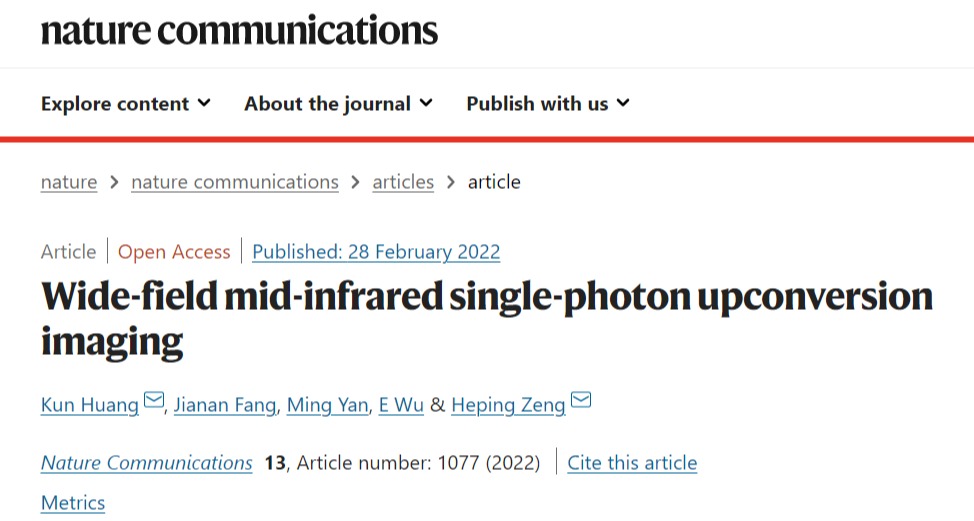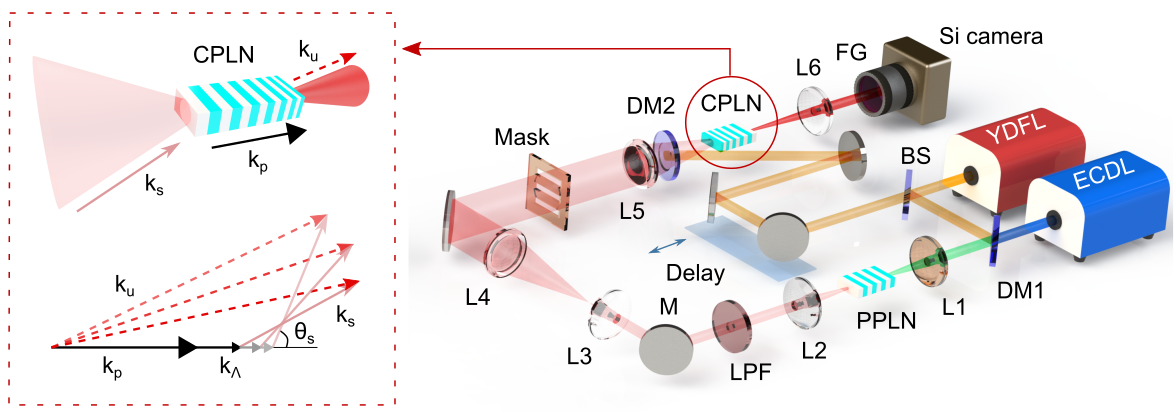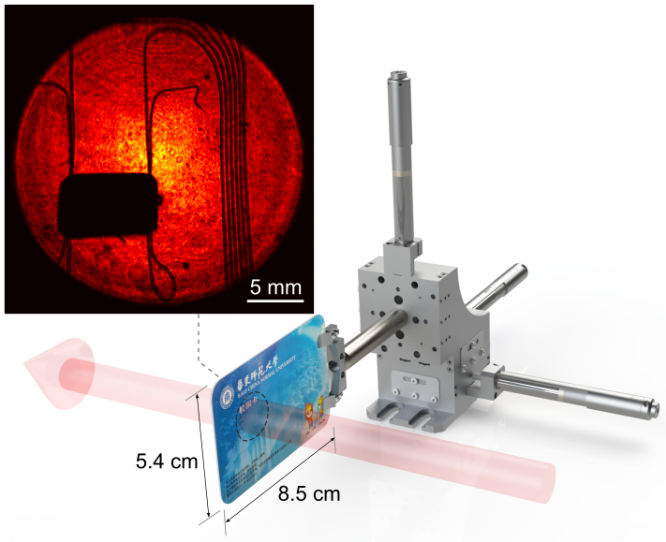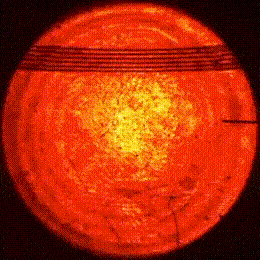Professor Zeng Heping's team at the State Key Laboratory of Precision Spectroscopy Science and Technology of East China Normal University (ECNU) has made important progress in the field of infrared sensitive imaging, proposing a new method of upconversion wide-angle imaging based on chirped polarised crystals, and realising mid-infrared photon imaging with a wide field of view, ultra-sensitivity and high frame rate, which can provide powerful support for molecular spectroscopy, astronomical observation, remote sensing of the environment, and biomedicine and many other fields. The results were recently published online in Nature Communications as a research paper entitled Wide-field mid-infrared single-photon upconversion imaging. Professor Heping Zeng and Kun Huang are the co-corresponding authors of the paper.

Research results of Prof Heping Zeng's group published in a sub-journal of Nature
The mid-infrared (MIR) band is located in the molecular fingerprint spectral region, covering multiple transmission windows of the Earth's atmosphere, and the realisation of ultra-sensitive detection and imaging in the MIR band not only promotes the development of basic research in molecular spectroscopy and space astronomy, but also has important applications in infrared remote sensing, pollution monitoring, and disease diagnosis. For a long time, how to achieve detection sensitivity close to the single-photon level is the international research hotspot in the field of mid-infrared photon measurement and control. In recent years, infrared upconversion detection technology has attracted much attention, which combines high-fidelity photon frequency conversion and high-performance silicon-based detector devices to provide a feasible way for infrared single-photon detection and imaging. However, the existing upconversion detection scheme is limited by the phase matching, the signal reception angle is small, and it is difficult to achieve wide-field-of-view imaging, which is the most important bottleneck that prevents this technology from advancing to a wider range of applications.

Schematic and device diagrams of wide-field mid-infrared upconversion imaging
To this end, Prof. Zeng Heping's team proposed a wide-angle upconversion imaging technique based on chirped quasi-phase matching, using chirped polarised lithium niobate (CPLN) crystals to achieve adaptive phase matching of incident signals at different angles, and obtaining a reception angle that is at least one order of magnitude higher than the traditional scheme. At the same time, the team combined the synchronised pulse pumping technique with the narrow-band high-efficiency filtering technique to effectively suppress the background noise, and obtained the mid-infrared large-field-of-view (MIRLoFoV) imaging at the single-photon level under the 1-photon/pulse very-low-illumination level. Further, the mid-infrared imaging system enables real-time scanning and detection of the internal structure of the campus card, and clearly identifies the card chip and the metal coil. The imaging technology is expected to be applied to semiconductor chip inspection, non-destructive material testing and other fields.


Scanning the internal structure of the campus card with the mid-infrared upconversion imaging system, the embedded chip and coil are clearly visible.
It is worth mentioning that the above upconversion wide-angle imaging technology can achieve large field-of-view imaging through a single acquisition, circumventing the reliance on mechanical scanning, parameter adjustment, or data post-processing in traditional solutions, and significantly improving the imaging rate. Specifically, the team used a high-performance silicon-based CMOS camera to achieve ultra-high-speed mid-infrared imaging, and photographed a high-speed rotating chopper in real time, with an outer-edge line speed of up to 30 m/s. Thanks to the high sensitivity of the imaging system, the camera exposure time in the experiment can be as low as the order of microseconds, and the mid-infrared imaging frame rate reaches 216,000 frames/s, which is an improvement of 2-3 orders of magnitude compared to the existing mid-infrared cameras. In addition, the system also has a high-precision three-dimensional imaging capability, using ultra-fast optical conformal gating technology, can accurately measure the relative flight time of the reflected signal photons, so as to get the surface of the measured object topographic information. Combining the advantages of high sensitivity, high resolution and high frame rate, the resulting large field-of-view imaging technology is expected to develop an ultrasensitive mid-infrared time-resolved spectroscopic imaging analyser, which can provide a new tool for high-throughput multi-dimensional (spatial-temporal-spectral) composite detection of organisms and materials.

Ultra-high speed mid-infrared imaging. The imaging frame rate in the lower right corner reaches 216,000 frames per second, and the playback frame rate shown in the figure is slowed down by more than 20,000 times compared to the actual rate.
In recent years, Prof. Heping Zeng and Kun Huang's group have carried out a series of work in infrared photon measurement and control, achieving ultrasensitive silicon-based infrared detection based on non-simultaneous two-photon absorption [Phys. Rev. Appl. 14, 064035 (2020)], and mid-infrared photon-number resolution by using high-efficiency upconversion detection [Photon. Res. 9, 259 ( 2021)], and mid-infrared single-photon fringe imaging combined with helical phase contrast technique [Laser Photon. Rev. 15, 2100189 (2021)]. The related work was co-funded by the Ministry of Science and Technology, the Foundation, the Shanghai Municipal Science and Technology Commission and East China Normal University.
Source: https://www.ecnu.edu.cn/info/1094/59617.htm
Link to paper: https://www.nature.com/articles/s41467-022-28716-8
